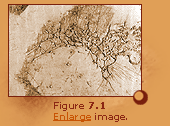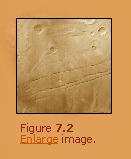|
|

Bulging and Tension
Tectonic processes represent surface geological processes derived from
stresses within the top surface of a planet. There are two areas on Mars
that have experienced major crustal up-warping. They are the Tharsis region
and the Elysium region (see volcanic process for their locations). The
up-warp of Tharsis is over 4000 km wide and the vertical deformation
exceeds 6 km.
|


|
This was probably produced by mantle processes such as solid-state
mantle convection. Because of the large-scale up-warping at Tharsis,
fracture systems either radial or concentric to the Tharsis bulge
are visible (Figure 7.1). This is a network of interconnected grabens
centered on the non-volcanic part of the Tharsis uplift and next
to the western edge of the Valles Marineris. It is clear that the
older, north-trending fractures were overlaid by the younger, more
chaotic system. Figure 7.2 is a close-up view of an area where troughs
are clearly visible.
|
1 2
3 next > |



